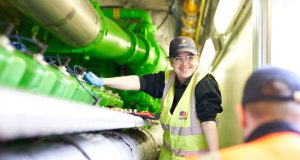Biophilic design is all about reconnecting human beings with nature. So why not get creative with your office planting and enjoy a walk on the wild side? says Kirsty Jones of Plant Designs
There’s a growing body of research suggesting the contribution of plants to the workplace is much more than aesthetic. Satisfying the human need to connect with nature (biophilia) makes people happier and more productive. Research by leading universities, including Washington State and Exeter, has shown that workers who can see greenery from their desks complete work up to 12 per cent faster and are less stressed than those in a ‘lean’ office environment. This in turn leads to an improved bottom line.
Plants also contribute to health by helping to improve indoor air quality. Indoor air is often more polluted than outdoor air due to the chemicals released from cleaning products, furniture and even flooring. However, according to NASA, plants in the right quantities and combinations can remove up to 87 per cent of indoor air toxins in just 24 hours. Plants can absorb chemicals such as benzene, formaldehyde and ammonia that are linked to headaches, eye irritation and minor respiratory conditions. More plants mean fewer sick days.
Plants have the potential to reduce energy bills by providing insulation and shade and helping to regulate indoor temperatures. They can be used to create attractive natural partitions in an open-plan office, absorb noise and help people to concentrate. And there’s a growing appetite for wilder, more creative planting schemes that bring a touch of the jungle to the workplace.
UNCOMMON, FULHAM
Uncommon provides co-working spaces across London that focus on arresting design with a strong emphasis on biophilia. The company recently opened a location in Fulham in which the key focal point is a living tree in the café.
The tree, chosen for its appearance, is Ficus ‘Nitida’, or Indian laurel. The spread of the crown and shape of the trunk was important, as the client wished the tree to look mature from the offset. It was installed in a planter on wheels, allowing it to be turned regularly to ensure that every part of the tree receives an equal amount of natural light.
There are also large planters for the floor space in a range of textures and finishes. Each of these pots is planted with a single large species, including Ficus lyrata (fiddle-leaf fig), Ficus elastica (rubber plant) and strelitzia (bird of paradise). Small pots in a variety of styles designed to complement the larger planters are placed on shelving, tabletops and credenzas. These are planted with smaller species including sansevieria, maranta and a selection of cacti and other succulents.
Additional hanging plants enclose the space in an abundance of green. A wide range of contrasting trailing plants create an exuberant, organic feel. Species include Cissus rhombifolia (grape ivy), Scindapsus aureus (Ceylon creeper), Lepismium cruciforme, Rhipsalis paradoxa (chain cactus), Senecio rowleyanus (string of beads), and tradescantia (spider lily).
LUSH HEAD OFFICE
 Cosmetic retailer Lush wanted its head office to reflect the importance of nature to its ethos. The company specialises in fresh, handmade products made from natural vegetarian recipes and organic materials, which have not been tested on animals. Lush also wanted the planting to complement the interior design of its building and respect its zero-waste policy.
Cosmetic retailer Lush wanted its head office to reflect the importance of nature to its ethos. The company specialises in fresh, handmade products made from natural vegetarian recipes and organic materials, which have not been tested on animals. Lush also wanted the planting to complement the interior design of its building and respect its zero-waste policy.
The two floors are filled with lush, broad-leaved foliage. The shape and form of the plants are organic and flowing, evoking the wildness of nature. They include Schefflera ‘Amate’, kentia (palm), Philodendron xanadu, Ficus lyrata (fiddle-leaf fig), and Strelitzia nicolai (bird of paradise). The pots are made from natural textures and colours. The planting scheme continues in the meeting room and coffee shop, with additional plants such as areca (palm), Calathea makoyana (peacock plant) and species of philodendron. Existing plants and pots were reused in keeping with the client’s zero-waste policy; plants that could not be used were composted.
WPP HEALTH & WELLNESS
WPP Health & Wellness, a global health and wellness marketing communications company, wanted an interior office planting scheme over two floors at its London office. The aim was to create maximum biophilic impact in each of the spaces while supporting the workplace’s functionality.
 This has been achieved using floor-standing and grouped plants, chosen to complement their surroundings. Plants were selected according to light levels and to create an inviting, organic feel. Planting was introduced at different sight lines, including built-in cabinet planters and shelving with trailing plants. Species include a wide range of philodendron, a huge Alocasia ‘Portodora’ (elephant ear), Strelitzia nicolai (bird of paradise), Ficus lyrata (fiddle-leaf fig), Beaucarnea recurvata (elephant’s foot) and areca palms.
This has been achieved using floor-standing and grouped plants, chosen to complement their surroundings. Plants were selected according to light levels and to create an inviting, organic feel. Planting was introduced at different sight lines, including built-in cabinet planters and shelving with trailing plants. Species include a wide range of philodendron, a huge Alocasia ‘Portodora’ (elephant ear), Strelitzia nicolai (bird of paradise), Ficus lyrata (fiddle-leaf fig), Beaucarnea recurvata (elephant’s foot) and areca palms.
“When designing our new working environment, which we describe as a Wellness Lab, our review of evidence led us to consider planting as an important and integral part of the design,” comments David Davenport-Firth, Wellbeing Officer, WPP Health Practice. “The impact has been significant.”




